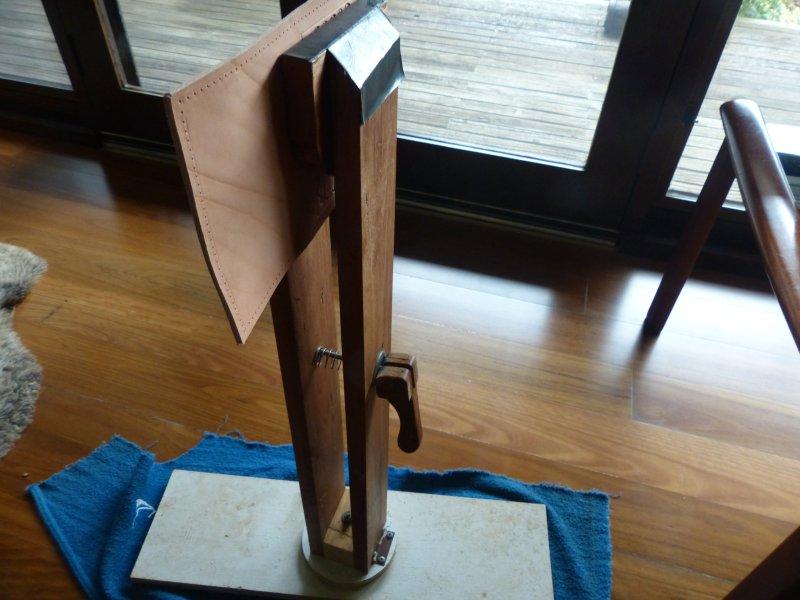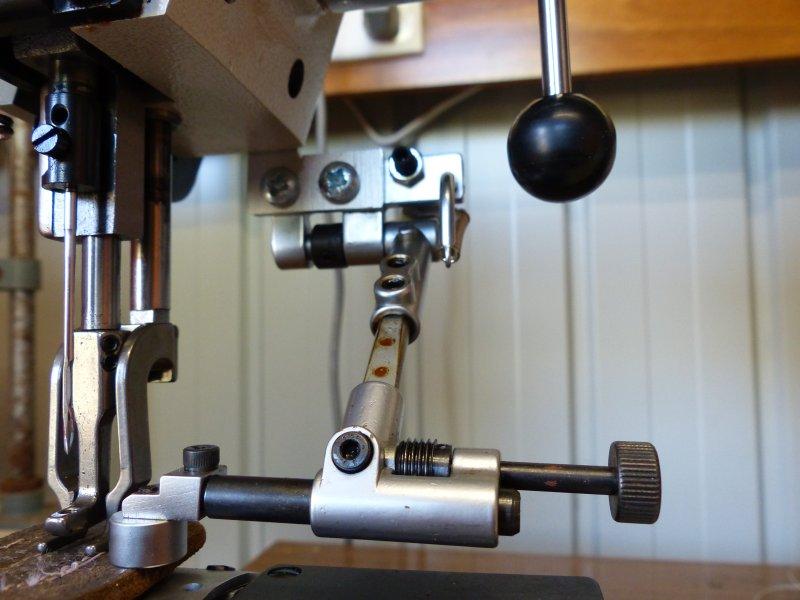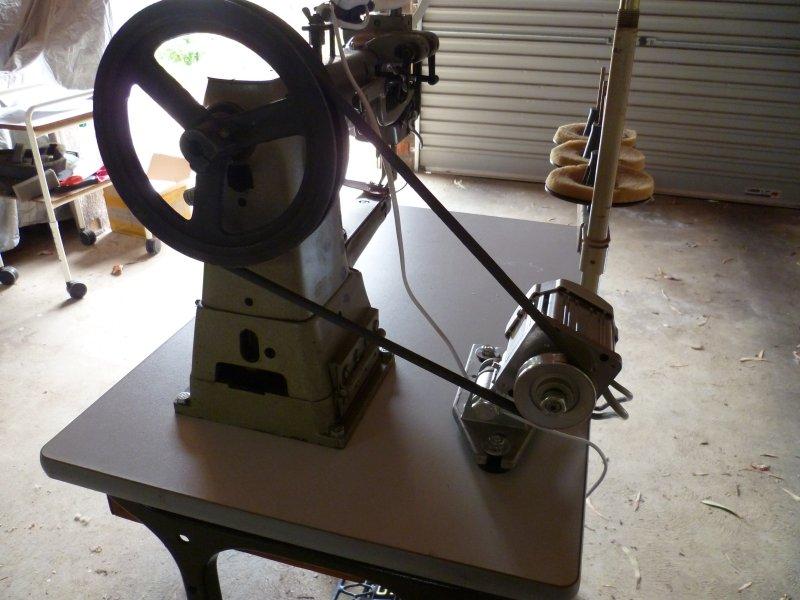-
Posts
4,808 -
Joined
-
Last visited
Content Type
Profiles
Forums
Events
Blogs
Gallery
Everything posted by dikman
-
Thanks Ross, those additional photos clarify things nicely. Slightly complex overall but a very clever design. This is mine, a bit agricultural () compared to yours but I needed something in a hurry when I started making holsters. One day (!) I will spend some time on it to make it a bit more refined. The handle can be rotated on the bolt to allow it to be tensioned more, depending on the thickness of the leather, and the pivot in the handle is offset to act as a cam. When sitting it sort of fits between my legs with my feet on the bottom board so it stays put! Mine is practical whereas yours is also aesthetically pleasing.
-
What's the lever at the front for?
-
Sam, I bought them off Aliexpress, they were cheaper than ebay. They're pretty much the same thing regardless of who sells them. Uwe may have pointed out the only real reason to consider the 4500 instead of the Seiko - spare feet availability?
-
That is very nicely done! A bit of advice, though, that bolt sticking out from the eccentric will catch the thread if you're doing long runs and the thread hangs down. Mine has a wooden lever on the side to act as a cam to lock it up and although I made it so the lever sits flat against the side it STILL catches the thread!!! You just need to knock a few chips off it and darken the wood a bit to make it look old.
-
Sam, a couple of photos of the Seiko and the 4500 with drop down guides. The Seiko is a piece of aluminium, the right hand screw is the supplied mounting screw, the second one is a longer one I had to go into the existing mounting hole and the third is the other supplied screw, tapped into the aluminium. The 4500 is simply an L-shaped piece of aluminium ('cos the mounting holes on the machine are vertical) and a couple of screws and nuts to hold the guide. Pretty simple really.
-
Yeah, I saw one set up to power a lathe. Nothing wrong with using the motor but it takes a bit of messing around to try and get the speed control so it's workable.
-
I'll take one later and post it here. It's not difficult, just a matter of cutting a suitable piece to line up with the holes in the machine and those on the guide. I had to do the same with the 4500. Does the 4500 come complete - table , motor and speed reducer? I assume you're dealing with the same people I dealt with (Jess)?
-
Sam, you mentioned #138 thread, if that's what you want to use then the Seiko will probably be the better machine. The 441 will be overkill for your bags. Realistically, unless you intend to make holsters, heavy gunbelts and do harness work a 441 will be too much machine and you'll probably end up fighting it when sewing lighter work. I agree with Matt, Seiko are solid well-built machines, when I decided to reduce the number of machines I had I sold the Singers and kept the Seiko. As for the 3 month warranty if you start using the machine you should soon discover if there are any issues within that warranty period. edit:you posted just as I did. I fitted a generic drop-down guide to mine, it was simply a matter of making a suitable bracket to attach it (nothing fancy). Another edit: I just realised I had the wrong model in mind (I should have looked it up before commenting - dumb!). The Seiko is pretty much their version of the 441. However, if you've tried it and it sews what you want then that's the one to get. I have a 4500, bought from the Qld folks, and I'm happy with the quality of the machine but the Seiko will definitely be a better quality machine. Plus you have the advantage of someone nearby if you do have questions/issues. And it's all set up and working.
-
I don't see how you could set copper rivets with a press (unless it's a heavy duty hydraulic press!).
-
Is this what you mean? I've done it with two motors (different brands but same construction). Just unbolt the controller. The limiting factor is the length of the cables.
-
The automation in the third video is quite amazing, but I really like the drop-down edge guide on the second machine, very neat and allows stitching very close to the edge. I think, however, that I'll stick to my simple old-style machines.
-
Very nice work. And yes, the glue helps a lot.
-
It's interesting to have that perspective from someone with an insight into marketing. If I had to try and start a small business I'd probably end up as one of the failed ones. A couple of reasons why - I'm a technical hands-on type of person, with little interest in the business side of things and I wouldn't be "hard" enough to run a profitable business because I would most likely be too willing to help people rather than make the tough decisions. Thanks for your thoughts, Spyros.
-

French style hand stitching process - where is the mistake?
dikman replied to justanil's topic in Sewing Leather
Those slits look awfully big (long) to me, particularly when you consider what it looks like when using an awl. -
At least with that colour it will be easier to see - wherever you put it down!
-

CB3200 or lower? Final decision/indecision
dikman replied to PALeatherArt's topic in Leather Sewing Machines
No worries, glad I could help. The 3200 is actually a nice machine, I was thinking of getting one but they offered me the 4500 at pretty close to the same price so naturally I had to buy the biggest I could! -

CB3200 or lower? Final decision/indecision
dikman replied to PALeatherArt's topic in Leather Sewing Machines
I did a bit of comparing and that photo is a 3200, not a 441. The specs in the .pdf you've listed are not for that machine. Do a search for Cowboy 3200 and you'll find the info relating to the machine in your picture. Someone at that company is a bit confused. The 3200 is a "lighter" version of the 441 with less lift and will only handle up to 1/2" under the feet. They rate it as handling #69 to #346 thread, but realistically you may have problems trying to sew thin leather because it's still a heavy duty machine. As for the Efka motor, not necessary in my opinion. These machines have a large handwheel and if you match that with a servo and speed reducer you should be able to sew as slow as you need. -

CB3200 or lower? Final decision/indecision
dikman replied to PALeatherArt's topic in Leather Sewing Machines
If it has "441" in its description then it's most likely a 441 clone, which is a heavier duty than a 3200. You need to download the specifications for what they're selling and compare them to the equivalent Cowboy models. That will give you a better idea of just what they're trying to sell you. I think you will be struggling trying to sew thin/light wallets on a 3200, and you definitely will on a 441! As Wiz said, it's an unfortunate fact that to sew the range that you have mentioned will require more than one machine. -
Good idea about the "repository" as there have been other files posted that are scattered in other posts.
-

Looking at buying a machine but overwhelmed.
dikman replied to Brigeyboo's topic in Leather Sewing Machines
Well, my Cowboy 4500 didn't come with a test sewing piece. I bought the head unit only from an Australian distributor and it was basically shipped to me unopened, as it came from the factory. My assumption is that if it was sold as a complete unit (table, motor etc) then it would have been tested because it was already set up. I'm not complaining because they gave me a good deal so I guess they didn't want to waste any time on it. Just my observations. -
Mate, it's safe to say that Victoria is a basket case at the moment! Australia, as a whole, was doing fairly well until these outbreaks in Vic started up. The people running that State should be shot (or exported to China). Glad to hear that things are picking up for you. Funnily enough, not much changed for me during all of this, the only real impact has been closure of the shooting ranges, but they're now starting to open up a bit. I haven't done any leatherwork (yet, I really should get back into it) but have spent a fair bit of time getting my larger lathe running on a 3-phase/VFD setup and getting it to run accurately (finally!). And built a gas forge. And melted some aluminium to make a bar to align the lathe. In fact, it seems I've been doing everything except leatherwork! You should post a couple of pics of your market setup, it could be of interest to others?
-
I wouldn't use chrome-tanned myself, due to the fact it's made using strong chemicals. I suspect that any moisture that gets in there is likely to combine with the residual chemicals and will doubtless affect the metal. Not worth the risk.
-
Something a bit different, bought them yesterday. Went to a second-hand shop chasing a bench grinder that they advertised but it was already sold. Looking around I saw these. I have a couple of pairs of cheapies that use AA batteries, and I found them very handy for cutting strips of material to make patches for my muzzleloaders and cleaning patches for all the guns. I knew that this model of scissors was very good so bought them. I found the original receipt in the box - 2005! - so don't expect the battery to last but so far it looks good. The cutters have carbide inserts and after touching them up with a diamond sharpener it cuts well. Can cut material (of course), canvas, garment leather and thinnish veg-tan. For $49 I'm sure I'll find a use for them.
-
Yep, I noticed that too. If both machines are the same price I would take the bottom (newer) one. I think it has slightly more lift under the feet?










